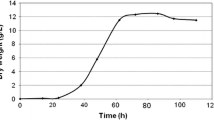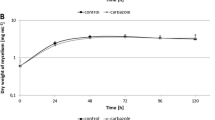Abstract
Submerged cultures of the ascomycete Chaetomium globosum oxidised the exogenous sesquiterpene (+)-valencene to nootkatone via the stereoselective generation of α-nootkatol. Inhibition experiments suggested that the first introduction of oxygen, the rate-limiting step of the bioconversion, may have been catalysed by a cytochrome-P450-monooxygenase. However, nootkatone was not the final metabolite: further flavour-active and inactive, non-volatile oxidation products were identified. (+)-Valencene and the flavour-active mono-oxyfunctionalised transformation products, α-nootkatol, nootkatone, and valencene-11,12-epoxide accumulated preferably inside the fungal cells. Di- and poly-oxygenated products, such as nootkatone-11,12-epoxide, were found solely in the culture medium, indicating an active transport of these metabolites into the extracellular compartment during (+)-valencene detoxification. These metabolic properties may have contributed to the high tolerance of the fungus towards the exogenous hydrocarbon.




Similar content being viewed by others
References
Arantes S, Fraooq A, Hanson JR (1999) The preparation and microbial hydroxylation of the sesquiterpenoid nootkatone. J Chem Res Synop 248:801–812
Demyttenaere JCR (2001) Biotransformation of terpenoids by microorganisms. In: Atta-ur-Rhaman HEJ (ed) Studies in natural products chemistry, vol 25 (Bioactive natural products, part F), pp 125–178
Hashimoto T, Asakawa Y, Noma Y, Murakaki C, Tanaka M, Kanisawa T, Emura M (2003a) Nootkatone manufacture with Chlorella from valencene or hydroxyvalencene. Japanese Patent 2003070492
Hashimoto T, Asakawa Y, Noma Y, Murakaki C, Furusawa M, Kanisawa T, Emura M, Mitsuhashi K (2003b) Manufacture of nootkatone with Mucor sp. Japanese Patent 2003250591
Hill RA (1993) Terpenoids. In: Thomson RH (ed) Natural products. Blackie-Chapman & Hall, London, pp 106–139
Huang R, Christenson P, Labuda IM (2001) Production of natural flavours by laccase catalysis. European Patent 1083233
Isken S, de Bont JAM (1996) Active efflux of toluene in a solvent-resistant bacterium. J Bacteriol 178:6056–6058
Kaspera R (2004) Oxyfunktionalisierung von Terpenkohlenwasserstoffen zu aromaaktiven Terpenoiden durch selektive Biokatalyse. PhD thesis, University of Hannover, Germany
Kraker J-W de, Schurink M, Franssen MCR, König WA, de Groot A, Bouwmeester H (2003) Hydroxylation of sesquiterpenes by enzymes from chicory (Cichorium intybus L.) roots. Tetrahedron 59:409–418
Lewis DFV (1996) Cytochrome P450: structure, function and mechanism. Taylor & Francis, London
March J (1992) Advanced organic chemistry: reactions, mechanisms, and structure, 4th edn. Wiley, New York
Meylan WM, Howard PH (1995) Atom/fragment contribution method for estimating octanol-water partition coefficients. J Pharm Sci 84:83–92
Mitsuyoshi O (1994) New microorganism and preparation of nootkatone. Japanese Patent 6303967
Noma Y, Hashimoto T, Murakami C, Furusawa M, Asakawa Y (2001) Microbial transformation of valencene, nootkatol and nootkatone. In: Kuldo J, Wawrzenczyk C (eds) 32nd International symposium on essential oils, Agricultural University of Wroclaw, p 32
Onken J, Berger RG (1999) Effects of R-(+)-limonene on submerged cultures of the terpene transforming basidiomycete Pleurotus sapidus. J Biotechnol 69:163–168
Reil G, Berger RG (1996) Genesis of aroma compounds in phototrophic cell culture of grapefruit, C. paradisi cv. White Marsh. In: Mottram DS, Taylor AJ (eds) Proceedings of the 8th Weurman flavour symposium. Royal Society of Chemistry, Cambridge, pp 97–104
Schrader J, Berger RG (2001) Biotechnological production of terpenoid flavor and fragrance compounds. In: Rehm HJ (ed) Biotechnology, 2nd edn. Wiley-VCH, Weinheim, pp 374–422
Shoji N, Umeyama A, Asakawa Y, Takemoto T, Nomoto K, Ohizumi Y (1984) Structural determination of nootkatol, a new sesquiterpene isolated from Alpinia oxyphylla Miquel possessing calcium-antagonistic activity. J Pharm Sci 73:843–844
Sime JT (1998) The natural choice. Chem Br 34:26–28
Teunissen MJ, De Bont JAM (1995) Will terpenes be of any significance in future biotechnology? Colloq Inst Natl Rech Agron (Bioflavour 95) 75:329–337
Werf MJ van der, de Bont JAM, Leak DJ (1997) Opportunities in microbial biotransformation of monoterpenes. In: Scheper T (ed) Biotechnology of aroma compounds. Advances in biochemical engineering and biotechnology, vol 55. Springer, Berlin Heidelberg New York, pp 147–177
Werf MJ van der, Swarts HJ, de Bont JAM (1999) Rhodococcus erythropolis DCL14 contains a novel degradation pathway for limonene. Appl Environ Microbiol 65:2092–2102
Willershausen H, Graf H (1996) Mikrobieller Abbau von Lignin. CLB Chem Labor Biotechnol 47:24–28
Wüst M, Croteau RB (2002) Hydroxylation of specifically deuterated limonene enantiomers by cytochrome P450 limonene-6-hydroxylase reveals the mechanism of multiple product formation. Biochemistry 41:1820–1827
Ziegler FE, Reid GR, Studt WL, Wender PA (1977) Stereochemistry of dialkylcuprate additions to cyclopropyl acrylic esters. An application to the synthesis of (±)-eremophilone. J Org Chem 42:1991–2001
Acknowledgements
This project was supported by the Federal Ministry of Education and Research (BMBF 0330062) and is part of the joint initiative project ‘Biologisch aktive Naturstoffe—Chemische Diversität’ at the University of Hannover. We thank E. Hofer of the Department of Organic Chemistry from the University of Hannover for his help in NMR analyses
Author information
Authors and Affiliations
Corresponding author
Rights and permissions
About this article
Cite this article
Kaspera, R., Krings, U., Nanzad, T. et al. Bioconversion of (+)-valencene in submerged cultures of the ascomycete Chaetomium globosum. Appl Microbiol Biotechnol 67, 477–483 (2005). https://doi.org/10.1007/s00253-004-1794-0
Received:
Revised:
Accepted:
Published:
Issue Date:
DOI: https://doi.org/10.1007/s00253-004-1794-0




